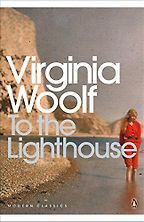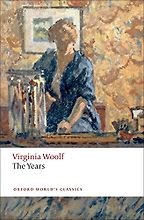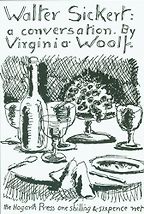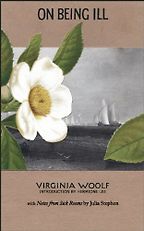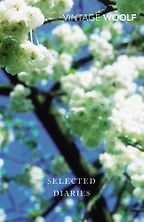Before we get to the books, let’s start this discussion by looking at your biography of Virginia Woolf. In it you mention that when you were studying English literature as an undergraduate at Oxford University, there weren’t any lectures on Woolf, and as a graduate student, you were told that Woolf was a ‘minor modernist’, not to be classed with the likes of James Joyce, T. S. Eliot or D. H. Lawrence. Why has so much changed since then?
I was a student in Oxford in the mid-sixties. That was the line on Woolf. Then, it was only twenty-five years since she died. After she died, in the middle of the Second World War, her reputation—which had been high in her lifetime—rather sank down. There was a feeling that she was an aesthetician and an experimentalist, an interesting, sensitive, delicate modernist, experimenting with ‘stream of consciousness’. That view lasted into the early to mid-’60s, and then several things happened. One, there was an enormous posthumous publishing of Virginia Woolf’s new book editions, her archives, her diaries, her letters, and it became increasingly clear that this was not someone who had just written nine beautiful novels, but a big figure, like Henry James or Thomas Carlyle. She began to be seen as a much more major figure. Second, the first substantial biography of her was published—by her nephew Quentin Bell—in two volumes, and that changed the perception of her. She became increasingly popular in America and in some of the European countries. And third, you’ve got second-wave feminism coming along at the same time. She is seen as more prolific and more professional. The life-story is more public because of the biography. And there are biographies of other Bloomsbury figures like Lytton Strachey; there’s a big rage for the life stories of all those people. And then there’s a social, literary and political movement for the revalidating of women writers. You have the beginnings of a publishing house like Virago in the ’70s, which is republishing neglected women writers. And so Woolf rides in and conquers the literary world on the back of all those things.
It must have been really exciting writing her biography when so many of her writings, diaries and letters had only recently become available, or weren’t available at all to the public.
I worked on a biography of Virginia Woolf in the early 1990s, and I had the great good luck that many things by then were in print, and were accessible. I was also able to go to the Berg collection in the New York Public Library and read the diaries—actually hold the diaries in my hand—which you are no longer allowed to do. I was writing in the wake of a lot of different versions of her through the ’60s, ’70s and ’80s. I think all biography is reactive: you’re writing in the light of what is out there. As well as her adoption as a feminist—which is of course absolutely right, and a tremendously creative way of thinking about her—she had also been adopted in the ’80s by a psychoanalytical movement that concentrated on what had happened to people in their childhood. There was a line of approach to Virginia Woolf around themes of childhood sexual abuse, around themes of the treatment of madness in her lifetime. She was being thought about as a victim or as an invalid, someone who suffered from attitudes to mental illness, captive to the claustrophobia of late-Victorian family life. I was reacting against that, in that I didn’t want to see her as a victim. I wanted to see her as a strong, prolific, energetic, politically-aware professional writer.
I was interested that you chose To the Lighthouse and The Years as your two favourite Virginia Woolf books. Why did you choose To the Lighthouse?
It’s a very difficult thing to be asked to choose your favourite novels, especially if you’re a Virginia Woolf biographer. I could just as happily have chosen Jacob’s Room or Mrs Dalloway. I chose To the Lighthouse because, when all is said and done, I think it is her greatest novel. I find it still, every single time I read it—and I must have read it more than any other book in my reading life—very moving, tremendously impressive, extremely complicated and interesting in how it’s put together, and approachable in many different kinds of ways. It’s approachable as a love story, as a family story, as a ghost story, as an elegy for the nineteenth century, as a war novel—in an indirect and interesting way—and as an astonishingly ambitious experiment in a completely different way of writing fiction.
It certainly is radically experimental. The literary critic Erich Auerbach famously analysed one scene in the novel, in which Mrs Ramsay sits knitting a stocking for the lighthouse keeper’s boy, and he points out that it probably takes longer to read this description than it would have taken Mrs Ramsay to knit. Why should we, as readers in the twenty-first century, be excited to read such slow-paced descriptions of seemingly trivial incidents?
There’s a fashion for that now. There could be another life of Virginia Woolf in the context of books like Elena Ferrante’s series on Naples, where you have a slow burn through the minute descriptions of the lives of her characters. Or Karl Knausgård’s autobiographies, where you spend fifty pages on slow processes of his life. John Updike is another example. The idea that you go minutely and slowly, in intense close-up, into moments in people’s lives, is something that people find interesting, perhaps because readers are fascinated by autobiography and memoir. What Woolf does in her narratives is to think about many kinds of different shapes and forms, like a painting, or abstract marks down the middle of a page, or the shape of a bowl of fruit, or the shape of a lighthouse in the bay. She tries to build a story almost like an abstract painting—and there’s a lot about painting in To the Lighthouse. It’s a novel that doesn’t just let you read the story, it makes you think about the shape and structure. She is interested in how to master the passing of time. She is obsessed with death and loss and elegy and memory. This is a kind of a ghost story. And you feel, at any moment, that the whole thing could fall apart into fragments if she didn’t keep on shaping it and shaping it. In the middle there’s an extraordinary section called ‘Time Passes’, where you see the house left on its own, beginning to decay, and then it’s brought back into life. You’re made to think about structure all the time. You don’t just read for the story—chapter 1, chapter 2, chapter 3. She’s making you think about how a narrative can shape the passing of time.
It’s an amazing middle section, ‘Time Passes’.
You don’t know who is speaking, there’s nobody there.
It’s very disconcerting.
I think these achievements are very modern and still fresh. Students who are now reading it for the first time are deeply interested in those kinds of experiments.
I remember being shocked by the way that Mrs Ramsay’s death is treated in ‘Time Passes’. Can you say a bit about that?
It’s a very bold thing to do. You get invested in the characters in the first part of the novel, even if you don’t like them much—and you’re not necessarily supposed to like them. There’s a rather tyrannical, eccentric father, Mr Ramsay, and the kind of mother who thinks that a woman’s life is about having children and bringing up families and matchmaking, and being attentive to the head of the family. She is not particularly interested in feminism or new ways for women to live their lives. There is the family with all the conflicts that go on inside the many children’s lives, and then there are the visitors, who are watching this family. Mrs Ramsay is a magnetic figure who pulls people towards her. It is partly a love story between the parents, and between the children and visitors who are all in love with her. And then she dies. She dies in brackets, in passing, in the middle section. The last section is about how they all live their lives after she has gone, and about their memory of her. The brutality with which she is chucked away in the middle section never fails to shock people when they read the book for the first time. Here is this woman you’re supposed to be minding about, then she’s killed off in brackets. That’s exactly what happens to people, and certainly happened a lot to Virginia Woolf. You’re living your life, and suddenly fate comes and wipes someone out—you don’t know why and you don’t know how. This brutal, fatal, sudden removal of people in whom you are deeply invested is something that she writes about over and over again.
So it’s almost more true-to-life than a prolonged death-bed scene?
She does do those too. But it’s a way of saying, ‘I’m not going to write the sort of novel in which I’m going to be sentimental about death’. She is very worried about being sentimental. She is worried about guarding her emotions from the page, and that’s why she’s so invested in form. She wants rhythm and form to create a wall from her personal emotions, so that they won’t be too raw on the page. There is another novel that I chose, The Years, which is very different, but is also a Victorian family story, in which there is a prolonged, Victorian death-bed scene, but she refuses to allow sentimentality in.
Let’s talk more about your second choice of Virginia Woolf books, The Years. At least at first glance, it seems a lot less obviously experimental than To the Lighthouse, or The Waves. It tells the story of the Pargiter family over three generations, which, on the face of it, is a fairly conventional thing to be doing. Is it a more straightforward novel?
In some ways it is, and it had a kind of success that suggests that people were reading it as if it were, say, like Galsworthy’s Forsyte Saga. It was a big commercial success in her time. Now it’s the least favoured of all her books, which is partly why I chose it: because I wanted to give it an airing. That and Night and Day, I would think, are the two least read. It’s not a transfixingly experimental book in the way that Mrs Dalloway or To the Lighthouse are. She called it her ‘failure’. She had a terrible time writing it, and kept changing her mind about what she wanted to do with it. But the reason why I think it’s interesting and important is that it’s an extremely political book. In The Years, the Victorian family that is growing into the modern world—the novel goes from the 1880s until the present day, which is 1936—is dealing with issues of feminism, of attitudes to women and the abuse of women, issues of abortion and child abuse, and women’s rights, racism and class war. These things are implicit in novels like Jacob’s Room or Mrs Dalloway or To the Lighthouse—novels of the 1920s—but in the 1930s, when all around her Woolf sees the rise of fascism, she feels, like other writers of the time, the need to speak about politics. She is extremely engaged with the public world.
The Years is a deeply flawed book, but it’s brave about political issues. In her mind, the late nineteenth-century world in which she grew up had all kinds of conventions and hypocrisies and rather stultifying ways of treating family life—in which girls, for instance, didn’t go to school if they were from an upper-middle class family, and sex was never spoken about, and young women had chaperones. The people of her generation get out of that. They go and live in Bloomsbury, they become artists, they are outspoken about sex. But they’ve lost something as well. They’ve lost a sense of solidity and gravitas and rootedness, and she struggles with that. She feels that the quality of modern life is thinner, somehow, than the quality of the life of her parents. The Years is partly about that, but it is also about individual struggles to make a meaningful life, at a time which seemed to her not helpful to individual fruition or fulfillment. She felt that the times were dark. And they were.
It coincides with a lot of her most overtly political writings.
It does. One of the reasons the novel was so difficult for her to write, and one of the reasons The Years doesn’t quite work, is that it is not what she meant it to be. She started a book called The Pargiters in the early ’30s. It’s a really interesting idea. She was going to have alternating chapters of political analysis of the situation for women and the middle classes, and what individuals did in a free country at the time of the rise of fascism. She had the polemical chapters interspersed with the life of her case-history family. Then she realized it wasn’t working, so she split the political stuff off, and turned it into a long essay called Three Guineas, which came out almost at the same time as The Years. She suppressed a lot of the polemics in the novel. She didn’t want it to be too loud-speakery, too like someone shouting at you at Speakers’ Corner. She was trying to be outspoken about the politics of her lifetime, and yet she thought that that was somehow against the grain of her aesthetic. It’s a quandary for her, and I’m interested in that tension.
Moving away from Virginia Woolf’s books and on to her essays, why did you select ‘Walter Sickert: A Conversation’?
What interests me about the Sickert essay is the ongoing conversation Woolf is having about the painters in her life, and her thinking about how a life-story can be told through words as opposed to through shapes and colours. The essay is based on her having seen a particular exhibition of Sickert paintings in London in the early ’30s, and then having a conversation about them with her painter friends, including her sister Vanessa, her brother-in-law Clive Bell, and Duncan Grant. She is always somewhat rivalrous with the painters, and deeply interested in painting. She has a painter in To the Lighthouse, who is constantly wondering, ‘how can I hold the balance between these parts of my painting?’, just as Woolf is always saying, ‘how can I hold the balance between these parts of my novel?’ In her essay, she makes up a biographical story behind one of Sickert’s paintings, but she tells us there is a ‘silent land’ which painters go into where they are talking about blocks of colour and textures and shapes, where the writers can’t follow. She is wistful about that silent land. She’d quite like to go there, but she has to use words. What she does with the Sickert painting, which is called Ennui—an untranslatable word meaning fed-upness or inertia or boredom or lassitude—is to make up a story about a man and his wife, and what a terrible marriage they have got, and how he is a publican living over a dreary pub. The story is completely invented from what she sees in the painting. And there are the painters saying: ‘look at the curve of that arm’, and ‘look at that block of red’, ‘look at the reflection in the mirror’, and she’s saying: ‘and think about how they have got to go down and open the pub and serve the customers’. It’s a wonderful enactment of the disparity between thinking about a subject as a writer, and thinking about a subject as a painter.
Writing about ‘On Being Ill’, you have distinguished between vertical and horizontal types of reading. Could you say briefly what the difference between the two is, and how this essay could be thought to be about horizontal reading?
Yes. Well, she’s horizontal because she’s ill and is lying on her back, and so the essay is about what it feels like to have given up the race to make your living and go out and live in the normal world. And so I suppose vertical reading would be orthodox reading where you are accountable and have to make sense of what you’re reading, and to be able to have an intelligent conversation about it once you have read it. Whereas horizontal reading is when you’re lying down with a raging temperature—perhaps you have got the flu—and you’re picking up books that happen to be lying around, as they would have been in her house, and you are biting off little bits of poetry, and little bits of stuff here and there, and you’re not even making sense of it. It’s almost like nonsense, but all kinds of unlikely and unexpected emotions are coming at you through the little fragments that you’re picking up here and there. Reading with a high temperature is a sort of illicit reading.
“What Woolf does in her narratives is to think about many kinds of different shapes and forms, like a painting.”
One of the things that is amazing about her—and I can’t really think of anyone who does it quite so well—is the way she writes about the body, and the relationship between the life of the body and the life of the mind. She was often ill, and not just mentally ill, but also physically ill. She had terrible phases of rapid heartbeat, she would get appalling headaches and migraines, she had tremendous problems with eating. There was a whole gallery of symptoms that had to do with being very vulnerable. She writes about these. There are astonishing descriptions in her first novel, The Voyage Out, of a woman with a mortal illness. You get inside that illness, and feel what it’s like. In her diaries and in her writing, she transcribes what it feels like to be in a particular physical state. This essay, ‘On Being Ill’, is one of the most remarkable pieces of writing about what it feels like to be writing out of ill health, not in a self-pitying way, but in an experimental way. Like the conversational essay on Sickert, it’s a very free associational piece of writing, so she’ll jump, with some wit and glee, between the most unlikely subjects.
I was interested that you chose Virginia Woolf’s diaries. Compared to her novels or her essays, they might be overlooked, or if not overlooked, mined for insights about the novels. Are they worth reading in themselves?
Yes, completely. It’s a life’s work for her. It’s an astonishing thing to have decades of almost daily diary entries from a great writer, who tells you about her work in progress, about her innermost thoughts, about the people she knows, about everything she’s been doing. They’re written in a different way from the novels, and she often talks in the diaries about how she’s writing them. She invents what she calls a loose, quick, free style; she’s trying not to correct herself. When you read them, the actual physical things, sometimes she’s writing so fast, with very few crossings out or blots, that you can see the line of the handwriting dipping down towards the end of the line. This is her mind pouring out at you. Of course, there are times when you can see she’s thinking, ‘maybe I’ll write a really good description of Yeats or H. G. Wells now, and then when I’m dead, people will publish my diaries, and read it’. There’s a slight self-consciousness there. But the diary works on many levels. It works as a practice book: she’s practising certain kinds of sentences. It works as a therapeutic book: she says ‘I’m going to calm myself down now by writing this in the book’. And it is a commentary on work in progress: she tells you the first thought she has of To the Lighthouse, or Mrs Dalloway.
Just to give you an example, there are a couple of pages, over four days in October 1922, where she moves from a visit from ‘Tom Eliot’, as she calls him—who she thinks may be wearing lipstick, and is somewhat overbearing and threatening to her, but is someone in whom she is much interested—to anxiety because her novel, Jacob’s Room, is about to come out, and then to a sense of great pleasure or freedom. She says: ‘At last, I like reading my own writing. . . . I have done my task here better than I expected’. She’s pleased for Jacob’s Room. ‘At forty I am beginning to learn the mechanism of my own brain—how to get the greatest amount of pleasure and work out of it. The secret is I think always so to contrive that work is pleasant’. Then somebody dies—an acquaintance called Kitty Maxse—and there’s a whole page on that, which has interrupted her train of thought. If you have read Mrs Dalloway, you can see that that death is somehow going to make its way into that novel. And then she jumps onto the fact that Jacob’s Room is coming out. She says to herself: ‘My sensations?—they remain calm’. It’s as if she’s telling herself: stay calm; how am I feeling? She’s monitoring herself in the diaries, taking her own temperature with a thermometer. Then she says she’s writing a chapter about Greek literature: ‘I must get on with my reading for the Greek literature’. She is reading ‘some Sophocles & Euripides & a Plato dialogue: also the lives of Bentley & Jebb’. All that is happening in two pages. Death, life, reading, publication, self-monitoring. Amazing.
If we are coming to the diaries for the first time, is this quite a good way of approaching them—just dipping in?
There are lots of different ways of doing it. If you want to start reading a particular Virginia Woolf book, say To the Lighthouse, what you can do is go to the index for the diaries, and look up To the Lighthouse. There’s a good index for the diaries in the five-volume edition. You can read all the entries of how she first thinks of the novel, how she’s working on it. You can read the diaries as a sourcebook for the writing. Or if you’re interested in how she reacts to, say, a visit to Thomas Hardy, you look up ‘Thomas Hardy’. Or you can just dip in. You can go to them for lots of different things. But you never go to them without feeling that you know this person, and that this voice is vividly coming at you off the page. We’re so privileged to have this. Thank god her husband Leonard didn’t do what she asked him to do, in the note that she left him when she went to drown herself, which was to destroy all her papers.
Five Books aims to keep its book recommendations and interviews up to date. If you are the interviewee and would like to update your choice of books (or even just what you say about them) please email us at [email protected]
Five Books interviews are expensive to produce. If you've enjoyed this interview, please support us by donating a small amount.


